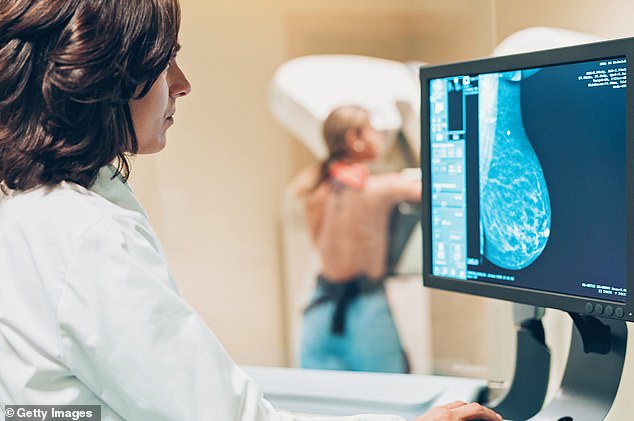Big change for breast cancer screening in every state: This is ‘critical’
Every health care provider in America is required to check the density of a woman’s breasts during routine breast cancer screening.
Starting this week, all mammogram reports and results letters sent to patients in the US must include a breast density assessment.
Mammograms are the gold standard for breast cancer screening, but the test can miss cancerous tumors if a woman’s breasts are dense, meaning they have a large amount of connective tissue relative to the amount of fatty tissue.
About half of women in the US have dense breasts, meaning they are at risk of being falsely told they don’t have cancer, which can spread the disease.
If it turns out that their breasts are primarily made up of dense fibrous tissue, the FDA recommends that they seek additional imaging with their doctor.
Fatty tissue, which appears dark on a mammogram, makes it easier to spot tumors because they are more noticeable than dense, fibrous tissue. Scan courtesy of Densebreast-info.org
For this reason, doctors in only 38 states and Washington DC were required to inform women about their increased risk of cancer.
In other states, there was no such requirement, even though dense breast tissue can increase the risk of cancer by six times.
Under new FDA regulations, all facilities across the country are required to disclose this “critical” information to patients.
Dense breast tissue appears white on x-ray mammograms. This can mask or hide small cancerous growths that also appear white.
This makes it difficult for doctors to distinguish between normal tissue and cancer.
Fatty tissue, which appears dark on a mammogram, makes tumors easier to see because they are more noticeable.
Dr. Hilary Marston, FDA’s chief medical officer, said: “Today’s action reflects the agency’s broader commitment to supporting innovation to prevent, detect and treat cancer.”
The FDA regulations, which take effect today, update the Mammography Quality Standards Act of 1992.
This law requires the Department of Health and Human Services (HHS) to develop standards and gives the FDA the authority to monitor the accreditation and certification of mammography facilities to ensure that screening quality standards are top-notch.
About half of women in the US with dense breasts are four to six times more likely to develop breast cancer than women whose breasts are composed mostly of fatty tissue.
Dense breast tissue is typically associated with advanced age, but nearly 75 percent of women in their 30s are diagnosed with dense breast tissue.
Mammograms are recommended for women over the age of 40. That means that about 12 million American women in their 30s with dense breasts don’t know it.
The best way to determine if someone has dense breasts is by having a mammogram. Younger women usually only have this done if they know that breast cancer runs in their family.
Teri Thomas, CEO of Volpara Health, which makes a widely used software tool to measure breast density in mammograms, said: ‘For more than a decade, we have been working with leading clinicians and researchers around the world to make important information about the composition of women’s breasts and its link to breast cancer more easily accessible.
“The FDA regulation validates our focus, increases the industry’s attention to breast density, and encourages society to improve the experience and understanding of both patients and healthcare providers.”
Breast cancer is relatively common in women. About one in eight will get it in their lifetime.
But the majority of cases – 66 percent – are diagnosed before the cancer has spread to the lymph nodes, bones and other organs, dramatically increasing the chances of survival.
But breast cancer is becoming more common. Incidence rates have increased slightly in recent years by 0.5 percent per year due to a combination of an overall older population, better screening methods and lifestyle factors such as alcohol consumption, physical activity and poor diet.
Now, cancer screening and radiology authorities are urging doctors to perform additional imaging tests when they find evidence of dense tissue.
Dr. William Dahut, Chief Scientific Officer for the American Cancer Society, said: ‘Mammography alone is not sufficient for women with dense breasts. Additional imaging, such as MRI or ultrasound, should be done.’

Women under 40, the recommended age to begin breast cancer screening, may not know they have dense breasts, increasing the chance that cancerous growths will go undetected for years
A new type of mammography creates 3D images of women’s breasts, while traditional mammograms only create 2D images.
Improved 3D imaging makes it easier for doctors to detect hidden cancer in the white tissue of the breast because pictures are taken from multiple angles.
Some studies have shown that ultrasound is more effective in detecting cancer than 3D mammography.
A Report 2022 conducted by doctors in Rochester, NY, found that ultrasounds detected more cases of invasive cancers than 3D mammograms alone. Ultrasounds alone detected 51 cancers not seen on 3D mammograms, while 3D mammograms alone detected nine cancers not seen on ultrasounds.
Another study published in 2024 advocated strongly for MRIs, especially in looking for signs of cancer between annual mammograms. Doctors in Italy and the UK found that a stand-alone MRI was more effective than 3D mammography in detecting breast cancer.
MRIs detected all 17 cases of invasive cancer and 83 percent of cancers that had not yet spread, while 3D mammography detected only 41 percent of invasive cancers and 33 percent of noninvasive cancers.
Under this revised regulation, the FDA will not require physicians who detect dense tissue to perform additional imaging tests, “but instead, the various options can be discussed by the patient and health care provider.
‘We believe it is more appropriate for the health care provider to discuss this information with the patient and make clinical decisions together based on the patient’s individual circumstances.’
